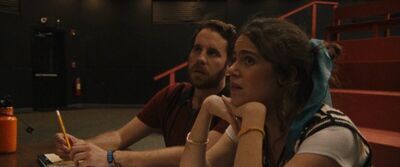Final Cut

A favorite college professor once compared listening to modern (i.e., 20th century) opera to doing homework, especially if you weren’t already familiar with the conventions, the tropes, and the general form that modern composers were either departing from or reacting to. I thought about homework as I watched “Final Cut,” a French remake of “One Cut of the Dead,” the meta-textual and often monotonous Japanese zombie comedy.
Like that recent word-of-mouth smash, “Final Cut” follows the making of a Z-grade horror movie within the movie, which is presented without commentary during the movie’s first half hour or so. The next 70+ minutes follow the making of that movie. There’s more dialogue in this remake, especially for its supporting characters, and therefore more attention is paid to the movie within the movie’s nature as a collaborative effort. But somehow, in trying that much harder to enunciate the original movie’s already clear message, the makers of “Final Cut” suck the fun out of the chaotic working conditions and heroic problem-solving skills required to make anything. The dead air and pregnant pauses now feel heavier, and while that’s sometimes amusing, “Final Cut” also rarely seems as playful or ingratiating as “One Cut of the Dead.”
To be fair, watching “Final Cut” didn’t remind me of doing homework because the movie required me to love or have deep knowledge of the filmmaking process. Rather, “Final Cut” is busy but not complex, clever but not smart, and involved rather than involving. Some film buffs might not be surprised to learn that “Final Cut” was directed and adapted by Michel Hazanavicius, whose toothless but watchable meta-comedies include the silent movie homage “The Artist,” the “OSS 117” spy spoofs, and the French New Wave sex dramedy “Redoubtable.” Others might wonder how the ideal viewer of “Final Cut,” who presumably already loves watching movies, is supposed to walk away feeling energized instead of exhausted.
Maybe it doesn’t matter that the 36-minute zombie pastiche that kicks off “Final Cut” looks both more polished and less dynamic than the one that begins “One Cut of the Dead.” The rest of “Final Cut” presumably matters more since that’s when we learn all about the fictional jobbers who made that tired-looking horror pic. Director Remi (Romain Duris) takes a paycheck and struggles to spin several plates after he’s offered a job by the genial but disengaged producer Mounir (Lyes Salem), negotiating on behalf of the Japanese TV executive Mrs. Matsuda (Yoshiko Takehara, in the same role that she previously had in “One Cut of the Dead”).
The stakes are low—Matsuda wants somebody who can deliver a cheap but engaging one-take horror movie to launch her new horror-themed streaming platform—but they seem high enough given the many schticky personalities working on the project. There’s the prima donna leading man Raphael (Finnegan Oldfield), who talks a lot about “veracity,” “volition,” and other haughty-sounding 25-cent words; Nadia (Berenice Bejo, Hazanavicius’ partner), a makeup artist and Remi’s wife; Philippe (Gregory Gadebois), a cameraman and a drunk; and Ava (Matilda Lutz), Raphael’s overwhelmed and over-worked co-star.
Remi’s feelings about making a zombie movie are quickly sublimated into the process of making a zombie movie. He paces up and down naturally lit hallways and staircases, either fills in or delegates last-minute problem-solving, and generally tries to keep everybody happy. He especially wants to please his wife and daughter Romy (Simone Hazanavicius, the real director’s daughter), who loves Raphael and is also very opinionated about authenticity. They race about the camera, put out various fires, and feverishly think on their feet in ways that will maybe re-orient how viewers see the zombie movie that begins “Final Cut.” Now it’s not just another schlocky potboiler—it’s a team effort, a hectic but thrilling high-wire act, a relay race, and a work-for-hire nightmare all in one.
Duris’ wired performance seems emblematic of the movie’s hectic mood, but much of the movie’s comedy dies on the vine, given how deliberately stretched out the movie’s pregnant pauses and dead air now feel. “Final Cut” feels long, even if it’s only about 12 minutes longer than “One Cut of the Dead.” However, that extra legwork does not confer greater depth, nor does this sort of high-concept stunt play to its cast or writer/director’s comedic strengths.
Some of the familiar and faithfully recreated twists and turns of the original “One Cut of the Dead” still land here, but not enough to make this leaden remake seem endearing or zany enough to pick through. By spoon-feeding movie lovers an overcaffeinated sendup of the filmmaking process, Hazanavicius and the gang have only dumped a bunch of pre-solved homework into viewers’ laps, leaving us to keep up as they cheerlessly show all their work.
Now playing in theaters.










